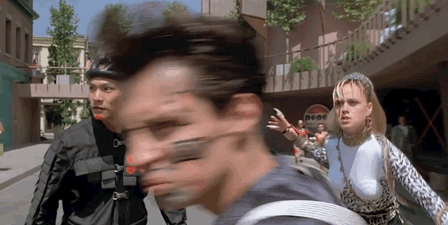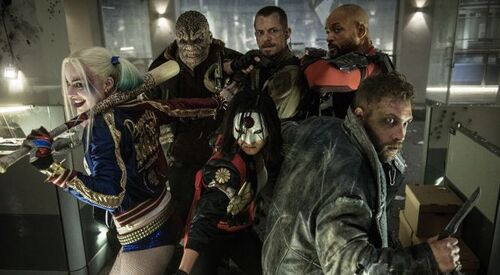
Movie Dude Series Special: Back To The Future
 In today's sensationalised, saturated media the most popular trends are set by those with the limelight upon them. More than ever celebrities are at the forefront of trend-setting, but who sets the trends of the trend-setters? “Retro” is paradoxically a current fashion statement, from the ghastly-coloured clothing to every accessory that compliments it. The choices made by these trend-setters are easily identifiable by the pop culture references and fashion statements that have endured since yesteryear. Right now its the 1980's all over again, and Back To The Future is quintessentially apart of this era of retrospective pop culture.
In today's sensationalised, saturated media the most popular trends are set by those with the limelight upon them. More than ever celebrities are at the forefront of trend-setting, but who sets the trends of the trend-setters? “Retro” is paradoxically a current fashion statement, from the ghastly-coloured clothing to every accessory that compliments it. The choices made by these trend-setters are easily identifiable by the pop culture references and fashion statements that have endured since yesteryear. Right now its the 1980's all over again, and Back To The Future is quintessentially apart of this era of retrospective pop culture.
Those who've taken even the slightest interest know the Back To The Future film series. Marty McFly's puffer jacket, his hover-board, “The Power Of Love” and most notably the DeLorean, have dominated the referential landscape since their 1985 début. It's unpredictable, because the premise sounds more like a straight-to-DVD b-grade sci-fi flick, but that's the hidden quality in Back To The Future. The puffer jacket, the hover-board and the DeLorean are what make these films tick. It's the look, somehow synonymous with its era yet still relevant today, that makes Back To The Future timeless.
The blueprints were laid by a simply question. Bob Gale, perusing his parent's garage, came across his father's high school yearbook, and wondered; had they met in time would they be friends? He took his query to business partner Robert Zemeckis, a critically successful (but commercially not-so) director who had years earlier barged into the office of Steven Spielberg and demanded he acknowledge the quality of his award-winning student film. At the time Gale and Zemeckis had been surviving from script to script, none of which were ever optioned. It wasn't until Michael Douglas saw in Zemeckis what Spielberg had seen that their fortunes changed.
Romancing The Stone was considered such a sure-fire flop that Zemeckis' next arranged job, Cocoon, was taken from him. But when Stone exceeded all expectations the suddenly in-demand director held some sway. He approached every major film studio with a script penned by himself and Gale, and was swiftly turned away each time. A list ditch effort saw the duo approach Disney, who summarily derided the story of an Oedipus Complex between a mother and son to be unsuitable for their family-friendly market.
Backtracking to 1981, Columbia Pictures, under whose watchful eyes the script had been written, placed in the project in turnaround while spending the next four years washing it's hands. Because studio executives don't get where they are without learning a thing or two about quality perception. However, once Stone set the box-office on fire Columbia decided that a story about time travel wasn't so bad. The only catch was Columbia were struggling through legal troubles relating to the film Big Trouble, a comedic re-imaging of 1944's Double Indemnity, owned by Universal Pictures. Universal had wanted to take their competition to the cleaners, but Frank Price, once an executive with Columbia, was so fond of the Gale and Zemeckis' script that he offered the green light to Big Trouble in exchange for the rights. Finally, the future had a nurturing home.
Despite the best efforts by Sidney Sheinberg to rename the project Spaceman From Pluto (because no film had ever been successful with the world “future” in the title), Back To The Future got the go-ahead in early 1984. Studio intervention dissipated when Spielberg became involved as a producer. Originally Michael J. Fox was the only man for the role of Marty McFly, but due to his commitments on the sitcom Family Ties he was unable to commit. Gale and Zemeckis' second choice, Eric Stoltz, filmed for five weeks before a shift in tone saw Stoltz's performance deemed too dramatic, a miss-match Stoltz himself noted. A twenty-hour work day was organised for Fox while the film-makers secured the extra $3 million they needed to re-shoot Stoltz's scenes (though one single shot survives in the film to this day). In response to the delays and the increase in budget ($11 million to $14 million), Universal placed a non-negotiable end-date on production. Whether it was in the can or not, they would be finished.
Filming wrapped in one-hundred days while the sound editors worked twenty-four hour shifts to make the July 3, 1985 release date set by Sheinberg. The original Alan Silvestri score was rejected by Spielberg, leaving Silvestri with only two weeks to re-write the whole thing (Silvestri would return for both sequels). Further to this, Universal were dissatisfied that “The Power Of Love” failed to feature the film's title. To placate this Huey Lewis & The News wrote the song “Back In Time” just to keep the executives happy. Because that's what's important.
Back To The Future hit theatres July 3rd, 1985, with the god-awful tag Are you telling me my mother's got the hots for me?. Despite the best efforts of Universal Back To The Future was a box-office number one hit for eleven consecutive weeks, grossing $383.87 million and becoming the highest-grosser of 1985. Initially a sequel was not planned, but money talks, so Zemeckis agreed to return as director as long as both Fox and Christopher Lloyd reprised their roles, which Zemeckis considered a long shot at the time. Funnily, the only cast members to not reprise their roles were Crispin Glover and Claudia Wells.
Things wouldn't eventuate for another four years while Zemeckis used his new-found success to directed Who Framed Roger Rabbit?. During this time Zemeckis and Gale conceived the idea for a third and final film from a conversation with Fox regarding an era in time he'd like to visit. This potential Part III would wrap up the story, though it required a budget of $40 million split evenly between the two sequels to make it happen.
The script for Part II took two years alone before shooting began. In order to avoid the pitfalls of trying to accurately depict a future that was then twenty-six years away, Zemeckis and Gale created a flourishing world to distinguish Part II's 2015 scenes from the modern trope of depicting the future as dystopian. Knowing their 2015 would never be truly accurate Gale and Zemeckis avoided focusing on a 'realistic' future. All fashion and technological advancements were featured based on their implausibility. Amazingly they would manage to identify 3D films, drones, wall-mounted flat screen televisions, video chat, conference call technology and a precursor to the Apple Watch.
Industrial Light & Magic, founded by George Lucas and employed on the previous instalment, would break new ground in special effects with the use of digital compositing and motion control camera's. This allowed Fox, Lloyd, Elisabeth Shue and Thomas F. Wilson to portray multiple characters interacting in single scenes, while camera movement was utilised within these scenes for the first time.
Filmed back-to-back with Part III, a three week period saw production on the two films overlap. While Gale supervised the finishing touches on the former, Zemeckis worked on only a few hours sleep while flying between Burbank (Part II) and several outdoor filming locations in Northern California (Part III).
Several measures were taken to make the western setting of Part III as authentic as possible. The town of Hill Valley was a life-size township built from scratch and included veteran western actors Pat Buttram, Harry Carey Jr. and Dub Taylor in the saloon scenes. By the time Part II had wrapped production the work on Part III was considered to be quite relaxed, but it was not without its setbacks. In accordance with the films authenticity Wilson insisted on performing his own stunts on horseback as well as learning to throw lariat. Fox took it one step further (and perhaps too far) by performing the hanging scene without simulation. Even the dancing scenes left Mary Steenburgen with torn ligaments in her foot.
Back To The Future Part II opened to somewhat mixed reviews but became the third-highest grossing film of 1989 with $331 million. Part III performed better with critics but didn't fare so well at the box office, grossing $244.5 million but still featuring at number six for film grosses that year. If ever there were evidence that the franchise had the stability to continue onward it's those numbers, but to date there are no plans for a fourth instalment. In fact both Gale and Zemeckis are staunchly against it. Plainly stated, they do not wish to tarnish their legacy in the name of a good pay day. Steadfast, they have contracts in place that state no film can be considered without their permission. They've also ruled out remakes, remasters and director's cuts. And when you consider the twenty-hour days Fox put in Zemeckis' plane rides between sets it's obvious they've earned that right.
Back To The Future Part IV is just not needed. The trilogy makes a perfect story with a beginning, a middle and an end. Besides, continuation exists in The Animated Series, the comic books, the 2011 video game and the short film Doc Brown Saves The World. The fix is there, it's jut not titled Part IV. So think not of what you don't possess, and appreciate what you do. Back To The Future has left an enduring legacy. Everybody knew the date of October 21st, 2015. The day Marty and the Doc travelled to the future. We celebrated in unison. I can't think of any other film that has incurred that particular type of fandom. But not only did we remember Back To The Future Part II but we stood by with anticipation. It was like awaiting the sequel all over again. Think about Part IV and ask; how can you top that?
Back To The Future is perfect the way it is. Not just for the plethora of pop culture references but also the quality film-making. The actors are synonymous with these films, they helped make them what they are and their characters remain just as noted and quotable as they day they were written. There's no reason to whip the horse until dead, let it retire healthy. There may come a time (after Gale and Zemeckis have passed on and it's legally possible) to add to the cinematic experience, but who knows? Gale and Zemeckis came close, but nobody can predict the future.


